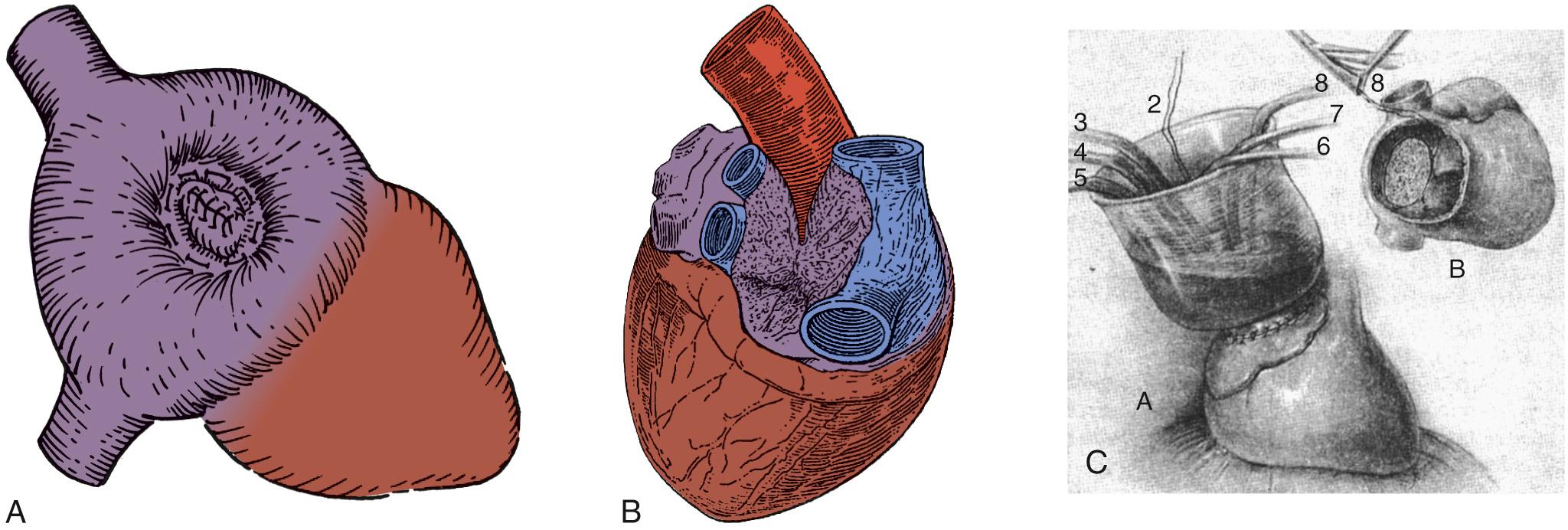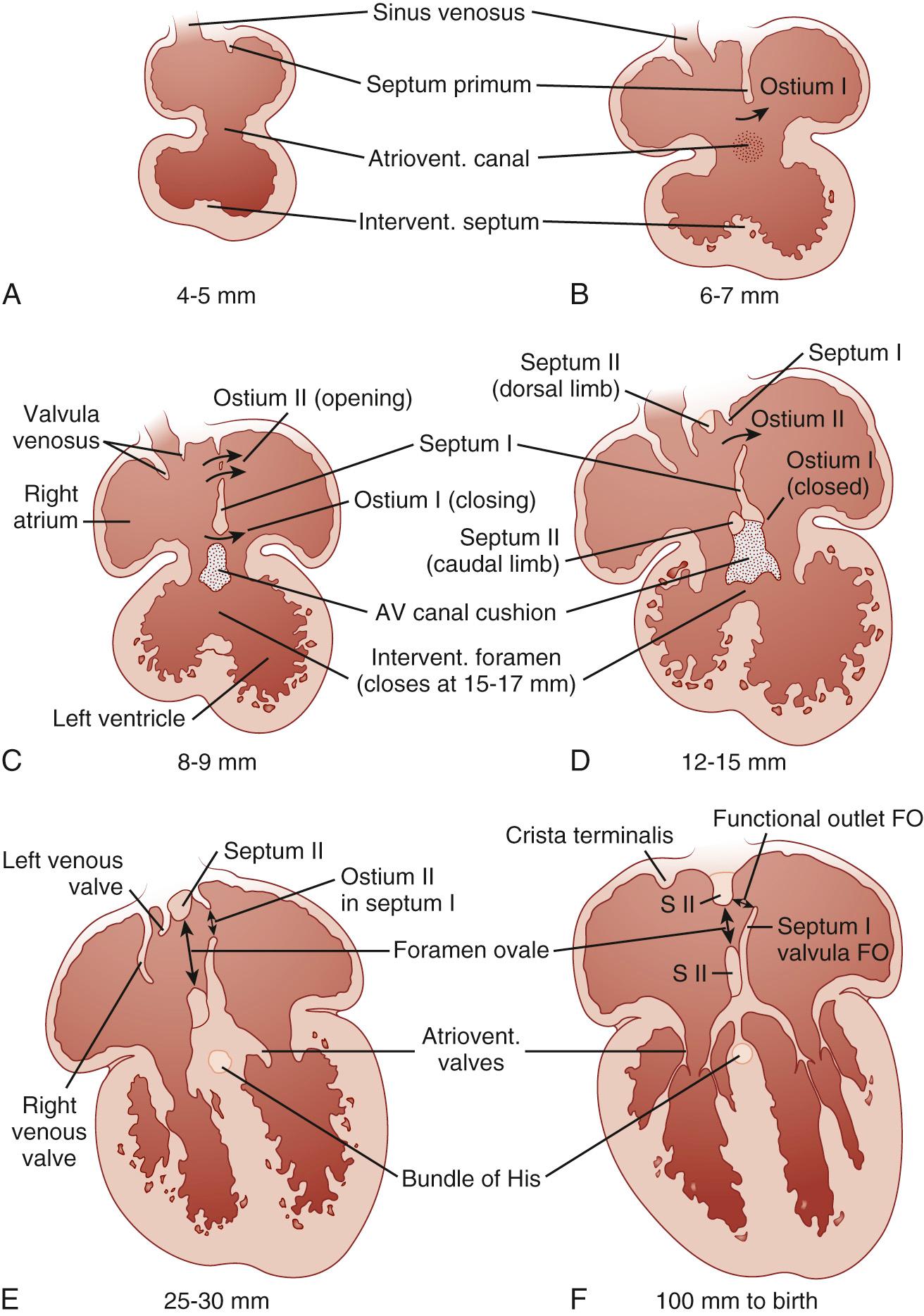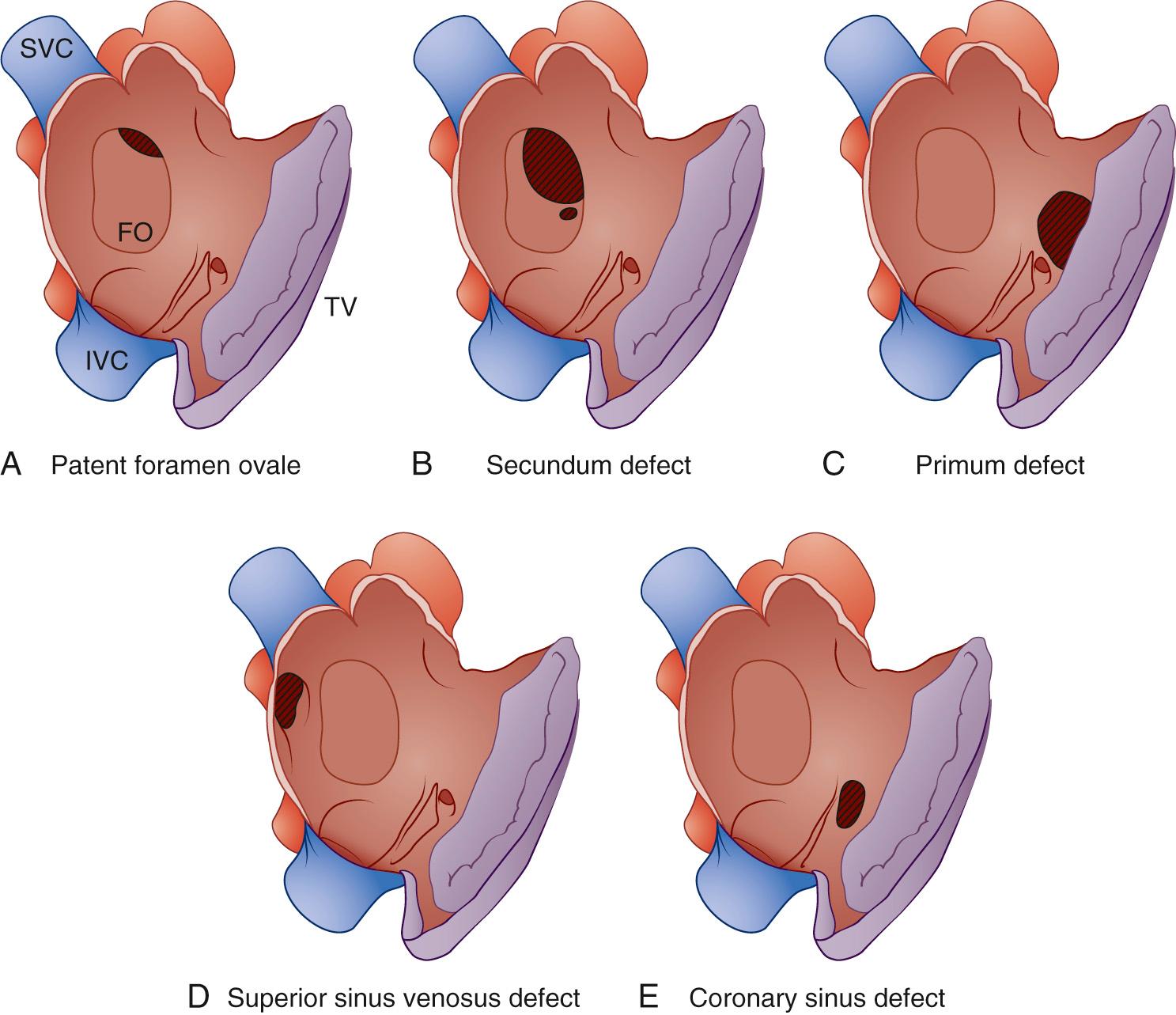Physical Address
304 North Cardinal St.
Dorchester Center, MA 02124
Ingenious and risky surgical corrections of atrial septal defect (ASD) predated cardiopulmonary bypass. The earliest closed approaches included a technique in which a straight needle with suture, guided by palpation, was passed blindly through the defect and both atria, and the free walls of the left and right atria were drawn together to obstruct the defect. Bailey and colleagues described the “atrio-septo-pexy” consisting of a digital invagination of the atrial appendage through the defect with external suture attachment of the atrial tissue to the perimeter of the defect ( Fig. 114-1 A ). Tyge Søndergaard devised a purse-string external suture closure of ASD by a near circumferential dissection around the defect in the plane of the interatrial groove and a plication of its edges (see Fig. 114-1 B ).

Semiopen techniques used before cardiopulmonary bypass became common practice included the “atrial well” technique, where a right atriotomy was formed, controlled by partial atrial clamping. A 15-cm tall, open-ended rubber cone was then attached to the atriotomy to produce an open column of blood in continuity with the beating heart. Working through the atrial well by palpation, the defect was closed by direct suture or patch. Regional intermittent heparinization prevented blood clotting within the well (see Fig. 114-1 C ).
Lewis and Taufic reported the first successful open-heart ASD closure under direct visualization, using surface cooling and circulatory arrest by inflow occlusion in 1953. Further modification of this technique to include continuous coronary perfusion improved the safety of this and other early intracardiac procedures and represented a precursor to modern myocardial protection techniques.
The modern era of cardiac surgery was heralded by the introduction of the pump oxygenator in 1953, and the earliest application of this technology was for ASD closure. Intracardiac repairs by inflow occlusion were not uniformly replaced by cardiopulmonary bypass techniques until 1960.
The embryonic common atrium undergoes partitioning by the formation of two parallel, overlapping septa, the septum primum and the septum secundum, starting in the fourth week of gestation.
The septum primum, emerging from the roof of the embryonic common atrium, begins the septation. The ostium primum, a gap between the septum primum and the atrial floor, almost closes by the completion of the septum primum. A de novo defect in the septum primum forms when a portion of its superior aspect resorbs, forming the ostium secundum.
The septum secundum, forming by the end of the sixth week of gestation, grows parallel to and immediately rightward of the septum primum, obliterating any remaining ostium primum, and circumscribing a central opening, the fossa ovalis.
In its final configuration, the atrial septum consists of the two layers, fused except for the overlapping, offset openings of the fossa ovalis and the ostium secundum. The free edge of the ostium secundum forms a flap valve covering the left side of the fossa ovalis, providing free right-to-left flow through the foramen ovale, until postnatal physiology closes the valve ( Fig. 114-2 ). Conditions impairing the competence of the valve, or abnormalities in the formation of its components, lead to a persistent interatrial communication.

Simultaneous with atrial septal formation, pulmonary vein connections with the primitive left atrium are forming. During the fourth week of gestation, the common pulmonary vein orifice forms from posterior invaginations of the sinus venosus segment into the mesenchyme of the primitive lung buds. The sinus venosus segment of the posterior common atrium forms where right and left omphalomesenteric and cardinal veins drain into the left and right sinus horns. An abnormal persistence of the right-sided anlage of the common pulmonary vein might be the embryologic basis for the development of abnormal connections of pulmonary veins to the right atrium, or partial anomalous pulmonary venous connection (PAPVC).
A familial predisposition to ASD is well documented. A study that included more than 18,000 subjects with congenital heart disease from a Danish population determined a recurrence risk for isolated secundum ASD of approximately 7%, a finding similar to prior studies.
Numerous genetic conditions and syndromes known for their extracardiac manifestations are also associated with ASD. Secundum ASD is the most common congenital cardiac defect associated with VACTERL ( v ertebral anomalies, a nal atresia, c ardiac defects, t racheal anomalies, e sophageal atresia, r enal anomalies, and l imb anomalies). Genetic syndromes with associated ASD include Holt-Oram, Rubinstein-Taybi, Okihiro, and Townes-Brocks syndromes. Trisomy 21 is associated with ASD either in isolation or as part of a constellation of endocardial cushion defects. Noonan syndrome is associated with ASD and pulmonary valve stenosis. DiGeorge syndrome (22q11.4 deletion) and Ellis–Van Creveld syndromes are associated with primum ASD. Additional specific genes implicated in familial forms of ASD include GATA4, NKX2.5, alpha-cardiac actin 1 (ACTC), alpha-myosin heavy chain (MYH6), and MSX1.
The conduction system forms concurrently with atrial septation and PR prolongation can accompany ASD, in likely association with abnormalities of the TBX5 transcription factor gene.
The patent foramen ovale (PFO) denotes a failure of the septum primum and septum secundum to fuse. A failure of fusion results in either a valve-competent, “probe patent” PFO or valvular incompetence with or without an aneurysm of the septum primum component ( Fig. 114-3 A ). Forces producing an enlarged foramen ovale or a deficient septum primum contribute to incompetence of the valve, a physiologically significant PFO, and transseptal shunting.

The secundum defect lies within the bounds of the fossa ovalis, widely ranging in morphology from the slit-like PFO at the superior aspect of the fossa, to defects involving part or all of the remainder of the fossa, with a single or multiply fenestrated communication. Defects of various specific morphologies classified as secundum ASD can form as a result of underdevelopment of the septum secundum or a malformation of the septum primum resulting in incomplete coverage of the ostium secundum (see Fig. 114-3 B ).
The primum defect is a persistence of the ostium primum and is most commonly associated with an atrioventricular (AV) septal defect (see Fig. 114-3 C ). This lesion is discussed further in Chapter 116 .
The sinus venosus interatrial defect is associated with a PAPVC. Ninety percent of PAPVCs are right-sided, 7% left-sided, and 2% bilateral. The most common subtype is right upper pulmonary vein–to–superior vena cava (SVC) connection, accounting for 74% of PAPVC cases, in usual association with sinus venosus ASD. The more common superior variant of sinus venosus defect is an interatrial communication lying posterior and superior to the true atrial septum, and the SVC overrides the defect. The right upper pulmonary veins, usually two or more, drain to the right atrium at the superior cavoatrial junction or enter the SVC directly (see Fig. 114-3 D ). In rare cases, they may enter the azygous vein as well. The SVC is commonly enlarged as it enters the right atrium.
The less common inferior sinus venosus defect is a communication inferior and posterior to the fossa ovalis with the right pulmonary veins entering the right atrium near the inferior cavoatrial junction. Although the sinus venosus ASD is remote from the fossa ovalis, a PFO or secundum ASD also may be present.
Redundant atrial septal tissue within the fossa ovalis with a respiratory excursion greater than 10 mm is termed an atrial septal aneurysm (ASA). The ASA may occur with or without a PFO and has been implicated in the formation of paradoxic embolus. ASA is present in 2% to 4% of the normal population, and 70% of cases are associated with a PFO.
The uncommon coronary sinus–type ASD results from a complete or partial unroofing of the coronary sinus along its course through the floor of the left atrium. A communication of the coronary sinus with the left atrium results in an interatrial communication at the level of the coronary sinus ostium, the size of which is determined by the extent of unroofing and the size of the ostium (see Fig. 114-3 E ). Concomitant cardiac lesions occurring with coronary sinus ASD include ASDs within the fossa ovalis, persistent left-sided SVC, and pulmonary or tricuspid atresia. The rarity of coronary sinus defects, their tendency to elude echo diagnosis, and the finding that many elude even intraoperative recognition, underscore the importance of maintaining suspicion for this lesion when the degree of intracardiac shunt observed is inordinate for the known defect elsewhere.
Iatrogenic ASDs are found after 87% of catheter-based transseptal pulmonary vein isolation procedures. Most are smaller than 1 mm in diameter and 96% resolve spontaneously, requiring no intervention. Rare cases of traumatic ASD after blunt or penetrating trauma have been described.
More than 60% of healthy full-term infants have a PFO identifiable on transthoracic echocardiogram. With the postnatal fall in pulmonary resistance and rise in left ventricular end-diastolic pressure, the pressure in the left atrium exceeds that in the right atrium, and the flap valve consisting of septum primum closes the foramen ovale. Fibrous adhesions form in the first year of life to seal the interatrial communication in most cases. Spontaneous closure rates of PFO diagnosed in infancy are high—87% to 96% for those diagnosed in the first 12 months of life. The overall incidence of persistent PFO in adulthood, deduced from autopsy specimens, is 27%. A PFO is present in one third of people younger than 29 years of age, one fourth of those 30 to 79 years, and one fifth of persons older than 80.
Secundum ASD occurs in 1.6 out of 1000 live births, second in prevalence only to ventricular septal defect (VSD). ASD accounts for 10% to 15% of congenital heart defects in children and 20% to 40% of defects discovered in adults. Women are affected twice as often as men. Maternal exposures associated with ASD in offspring include alcohol, hydantoin, valproic acid, and amphetamines. Infections and additional conditions associated with ASD include cytomegalovirus or rubella infection during pregnancy, diabetes, older maternal age, multigestational birth, and obesity. Low-birth-weight and premature infants have a higher prevalence of ASD than does the general population.
A significant number of ASDs close spontaneously within the first few years of life, but spontaneous closure after age 3 to 4 is rare. The likelihood of spontaneous closure is best predicted by the initial diameter of the secundum defect. Longitudinal data demonstrate that more than half of defects diagnosed in infancy and measuring 4 to 5 mm close spontaneously. Thirty percent regress in size to smaller than 3 mm. However, none close spontaneously when the defect measures larger than 10 mm at diagnosis. Defects larger than 8 mm at diagnosis usually enlarge over time. If there is aneurysmal formation, sizes diminish regardless of whether they are larger than 8 mm.
In contrast to children with ASDs, most patients older than 40 years of age are symptomatic and have evidence of elevated pulmonary vascular resistance. If these patients are not treated, their average life expectancy is 40 to 50 years. Seventy-five percent die by age 50, and 90% die by 60 years of age. Even the asymptomatic adult with ASD has a measurably diminished aerobic exercise capacity, which further declines with advancing age. A 2008 European heart survey of 882 adults with isolated secundum ASD, including 505 unrepaired patients, demonstrated a precipitous rise in the prevalence of right ventricular dysfunction in unrepaired patients after 45 years of age. The degree of right ventricular volume overload was the best predictor of reduced exercise capacity. A steady rise in the prevalence of pulmonary hypertension was observed in unrepaired patients after age 30. Findings support the suggestion that the magnitude of the intracardiac shunt may increase over time. Hemodynamically small defects tend more to remain stable and may not require closure.
Isolated ASD can predispose the patient to subacute bacterial endocarditis, although the actual incidence of endocarditis in this setting is rare. Scattered case reports describe atrial septal endocarditis in direct association with native ASD, ASD repaired by surgical or device closure, and by septal involvement of endocarditis that extends from other intracardiac structures. Risk of endocarditis from an unrepaired ASD is sufficiently low that antibiotic prophylaxis is not recommended, according to the latest American Heart Association guidelines. Incompletely repaired defects and those closed with prosthetic material or devices suspected of incomplete endothelialization are regarded as endocarditis risks, and do require antibiotic prophylaxis for dental or surgical procedures.
Isolated ASD in infancy and childhood is seldom symptomatic, even for large defects, and symptoms of congestive failure should prompt a careful effort to rule out additional associated abnormalities. Associated lesions found in the study of infants with ASD dying in the first year of life included left-to-right shunting lesions, such as VSD or patent ductus arteriosus (PDA); right-sided obstructive lesions, such as pulmonary stenosis; and left-sided obstructive lesions, such as aortic stenosis, mitral stenosis, or coarctation of the aorta. Necropsy data show that patients with VSD had an associated ASD in 18% of cases, those with left-sided obstruction had an associated ASD in 29% of cases, and those with right-sided obstructive lesions had ASD in 31% of cases. These associations support the hypothesis that some secundum ASDs are acquired, driven by remote lesions that favor persistent atrial level shunting and atrial dilation, in turn leading to valvar incompetence at the fossa ovalis.
Mitral valve abnormalities have long been recognized as associated with ASD, although their associated incidence is uncommon. Mitral stenosis with pulmonary artery dilation in association with ASD, or Lutembacher syndrome, was perhaps a more frequent association found in the era when rheumatic heart disease was more prevalent, although nonrheumatic mitral stenosis is occasionally found in association with ASD. A cleft anterior mitral leaflet, mitral prolapse, or regurgitation has also been reported in uncommon association with ASD. Mitral prolapse may be a result of septal distortion by right ventricular volume overload and a secondary effect on mitral valve geometry. As evidence in favor of this hypothesis, mitral prolapse has been shown to reverse after ASD closure.
Tricuspid regurgitation in association with ASD is usually caused by annular dilation from the enlarged right ventricle, and it also reverses with ASD closure. The most common additional cardiac anomalies associated with ASD include PAPVC, VSD, PDA, persistent left SVC, pulmonary valve stenosis, and branch pulmonary artery stenosis.
P wave prolongation associated with ASD may predispose the patient to the eventual development of atrial fibrillation. P wave duration may be shortened by ASD closure in younger adults, suggesting that the chronicity of atrial stretch is a contributing factor. Closure of ASD in older adults does not affect this electrical pathophysiology and does not shorten preexistent P wave prolongation. The presence of paroxysmal atrial fibrillation prior to ASD closure results in no shortening of P wave duration by closure.
Become a Clinical Tree membership for Full access and enjoy Unlimited articles
If you are a member. Log in here